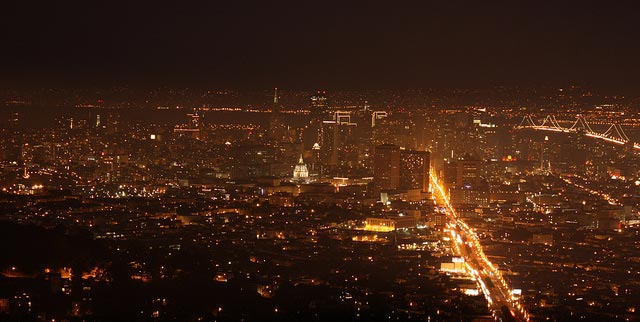
San Francisco – High on bluffs overlooking the Pacific, Dominik Mosur was strolling along at 2 a.m. searching for owls. Darkness enveloped the Presidio, a historic military encampment turned national park, as Mosur made his way through cypress-scented fog.
Alert in the mist as he cut through a forest, Mosur listened for the hoot of the great horned owl. Instead, he heard the singing of a bird that should have been asleep in its nest until dawn. The Nuttall’s white crowned sparrow was throbbing away with its distinctive zu-zee trill.
To this day, Mosur wonders whether the bright street lamps, 50 feet from the songbird’s territory, caused its odd nocturnal behavior, which usually is limited to moonlit nights along this part of the coast.
Mosur puzzled over the toll that the nighttime singing was taking on the songbird: Would it have the energy in the morning to defend its territory, attract a mate and raise its young?
Around the world, scientists seeking to answer that question have gathered mounting evidence that city lights are altering the basic physiology of urban birds, suppressing their estrogen and testosterone and changing their singing, mating and feeding behaviors. One lab experiment showed that male blackbirds did not develop reproductive organs during the second year of exposure to continuous light at night.
Streetlights, shopping centers, stadiums and houses turn night into day, a phenomenon that scientists call “loss of night.”
“Birds are particularly sensitive to light and different chemical interventions. If you see these deleterious effects in the birds, you’re likely to see them in humans in short-order. The smart thing to do is to pay attention to avian life,” said Vincent Cassone, whose University of Kentucky lab examines neuroendocrine systems of birds and mammals.
People can suffer an array of health problems when they work night shifts that alter their circadian, or daily, cycles governed by a biological clock. In the wild, light pollution causes hatchling sea turtles to lose their way from beach to the ocean, and disorients Monarch butterflies searching for migration routes. In field experiments, Atlantic salmon swim at odd times, and frogs stop mating under skies glowing from stadium lights at football games. Millions of birds die from collisions with brightly lit communication towers, and migratory flocks are confused by signals gone awry.
More recently, researchers have documented an earlier dawn chorus, which influences mate selection, feeding and interplay among species. At a deeper, molecular level, the changes in birds’ hormones raise questions about their reproductive fitness and the potential for ecological and evolutionary consequences.
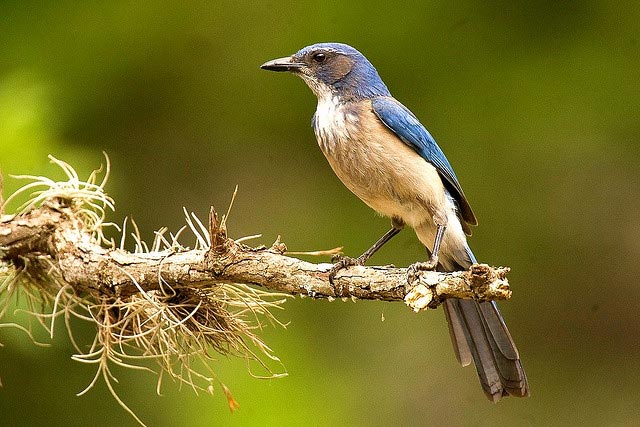 Western scrub-jays were used in an experiment that showed sex hormones were altered by artificial light at night. (Photo: Francesco Veronesi)
Western scrub-jays were used in an experiment that showed sex hormones were altered by artificial light at night. (Photo: Francesco Veronesi)
“Under light at night, something gets broken and you see a dampening of their hormonal system,” said University of Memphis biology professor Stephan Schoech, who found hormone changes in western scrub-jays.
Birds’ intricate clocks
The yearlong cycle of light is the most important environmental cue for birds because it synchronizes their seasonal changes in physiology and behavior. Because artificial light upsets hormone levels and signals, it could disrupt their intricate clocks evolved to help them cope with their complex environments.
“Birds can tell time in their brains. They know what time of day it is, what tomorrow is going to be like. They know where they are in the world using solar information. They can track the sun. They hear the sound of ocean breakers and wind over mountains. Birds see in the ultraviolet range. They are phenomenally attuned to time and space to the point of approaching science fiction. You don’t need science fiction,” Shoech said.
Birds have light receptors in their retinas and in their pineal glands, as well as in other parts of their brains. The pineal gland secretes the hormone melatonin at night, which guides their biological clocks controlling body function, growth and behavior. In birds, melatonin appears essential to encode and store information about time.
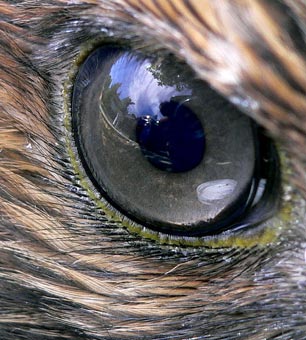 Birds have light receptors in their retinas. (Photo: Steve Jurvetson)Like humans, birds are diurnal, mostly evolved to a cycle of daytime activity and nighttime sleep. Birds synchronize their internal clocks with light to time their daily and seasonal foraging, communication, reproduction and migration. Birds depend on sounds they hear, and adjust their behavior to the rhythm of night and day. The timing of the first calls at sunrise – the dawn chorus or daybreak song – is based on changing light intensities. The end of foraging is based on darkening twilight.
Birds have light receptors in their retinas. (Photo: Steve Jurvetson)Like humans, birds are diurnal, mostly evolved to a cycle of daytime activity and nighttime sleep. Birds synchronize their internal clocks with light to time their daily and seasonal foraging, communication, reproduction and migration. Birds depend on sounds they hear, and adjust their behavior to the rhythm of night and day. The timing of the first calls at sunrise – the dawn chorus or daybreak song – is based on changing light intensities. The end of foraging is based on darkening twilight.
Some birds appear to benefit from artificial night light. Male blue tits exposed to streetlights on the edge of a forest awaken earlier and are twice as successful in attracting females than birds in the inner forest. In light, females start laying eggs earlier. Shorebirds can increase foraging time under urban illumination.
But researchers caution that premature dawn calls may disrupt age-old signals for choosing mates, and expanded feeding may draw wading birds to degraded areas or to danger from predators.
We don’t know if being active at night comes with energetic costs,” said biologist Davide Dominoni, who conducted research at the Max Planck Institute for Ornithology in Munich before moving on to the University of Glasgow.
Little is known about how the increase in length of day for the birds affects their fitness, reproductive success or survival.
“There might be a physiological or biomedical cost. With humans, we are starting to realize that disrupting body clocks can really come with serious health consequences linked to immune function, metabolism, cancer, obesity and diabetes. These types of things are relatively unexplored in wild animals,” Dominoni said.
Astronomers were the first to caution about the harm that comes from sky glow, since it blocked views of faint celestial objects. Then came NASA photos of Earth from space: First the image of the Blue Marble, showing a small finite planet, then decades later, the Black Marble, showing the night sky invaded with artificial lights.
Two-thirds of the world, and 99 percent of the United States’ lower 48 and the European Union, live under conditions of light pollution. City lights can outshine natural night sky by 4.8 times, according to European scientists. In Vienna and Plymouth, England, the natural cycles of moon brightness are close to extinct.
In 2001, scientists reported that one-fifth of the world population, and more than two-thirds of the U.S. population, can’t see the Milky Way with the naked eye
“You can see how artificial light is spreading over the world, as much as a 20 percent increase a year in some geographic regions,” said Reinhard Klenke, a biologist at the Helmholtz Centre for Environmental Research in Leipzig, Germany.
Testosterone, estrogen altered
Seventy-five miles away from the Presidio, in Davis, Calif., researchers tiptoed in the low bushes trapping and netting western scrub-jays. Schoech has been studying Florida scrub-jays for more than 20 years. At this point he was investigating why the jays living in Florida suburbs were laying eggs two to four weeks earlier than jays in native wildlands.
Schoech and his post-doctoral student, Eli Bridge, recruited energetic University of California students to help capture two dozen wild scrub-jays in Davis. Packing them carefully in modified pet carriers, they trucked the jays back to the Tennessee lab to serve as surrogates for the Florida scrub-jays, which are a protected species.
Schoech’s experiment was likely the first to study birds’ sex hormones in both females and males in response to realistic exposures mimicking suburban lights. He demonstrated that artificial light tended to inhibit reproductive hormone secretion, confirming limited findings by others. The reductions of sex hormones – estradiol and testosterone – occurred at different times in females and males, creating a mismatch in cues that synchronize biological rhythms.
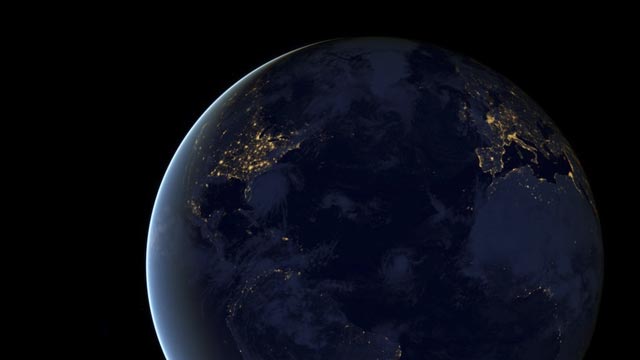 A satellite looks back at the night side of our planet Earth twinkling with light. Astronomers were the first to caution about the harm that comes from sky glow. (Photo: NASA)
A satellite looks back at the night side of our planet Earth twinkling with light. Astronomers were the first to caution about the harm that comes from sky glow. (Photo: NASA)
“Light at night disrupted the extraordinarily strong correlation between testosterone and estradiol in jays of both sexes that existed under unlighted nocturnal conditions,” Schoech said.
In natural darkness of night, birds’ reproductive hormones rise as the winter turns to spring and days lengthen. This did not occur among the jays exposed to night light. Instead, “light at night interfered with endocrine responses to increased day length,” Schoech said. At the end of the experiment, it turned out that the earlier scrub-jay eggs in Florida’s suburbs probably had more to do with abundance of food than artificial light. But their investigation led to the intriguing findings about hormones and night light.
In Beijing, scientists published findings this year similar to Schoech’s, concluding that urban tree sparrows exposed to artificial night light began to secrete a reproductive hormone earlier than rural tree sparrows. The urban birds’ estradiol and testosterone levels were lower than those of rural birds.
In addition, male blackbirds exposed in a laboratory to light at night developed testes faster during the first year. “During the second year, the reproductive system did not develop at all,” according to a report by Dominoni and colleagues published last year. They wrote that “our data suggest that an uncontrolled increase in the amount of artificial light at night could pose serious risks for the reproductive capacity of avian species thriving in urban areas.”
Nevertheless, Cassone of University of Kentucky said “the rub is how these endocrine changes translate into reproductive fitness. We frankly don’t know. It’s too early. It’s a reasonable thing to say that it’s disturbing a natural process.”
Night skies aglow
On San Francisco’s clear Indian summer nights of September and early October, Mosur, a local bird expert, sets his spotting scope at the moon, hoping to catch silhouettes of warblers, thrushes and sparrows.
“That’s when birders hope to hear, if not glimpse, the nocturnal migration of songbirds passing over on the way south,” Mosur said.
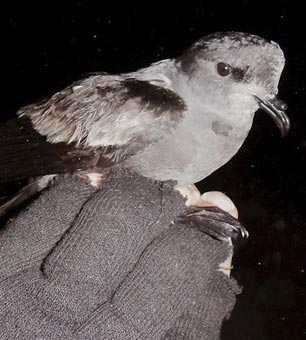 Ashy storm petrel, pictured here, is attracted to lights at the Giants’ baseball stadium. (Photo: Ilana Nimz / PRBO Conservation Science)Like any big city, San Francisco struggles with lights. The bright lights of the Giants’ baseball park attract ashy storm petrels from nests 30 miles away, on the Farallon Islands. Residents argue over whether putting up lights on a soccer field in Golden Gate Park will interfere with bird migrations.
Ashy storm petrel, pictured here, is attracted to lights at the Giants’ baseball stadium. (Photo: Ilana Nimz / PRBO Conservation Science)Like any big city, San Francisco struggles with lights. The bright lights of the Giants’ baseball park attract ashy storm petrels from nests 30 miles away, on the Farallon Islands. Residents argue over whether putting up lights on a soccer field in Golden Gate Park will interfere with bird migrations.
“I’ve noticed the night sky looks a lot different when I’m standing on Twin Peaks in the city or on a ridge near Lake Hennessey 20 miles north of Napa. There’s a big difference what you see in the sky,” he said. “I’m sure the birds see the differences, too.”
Join us in defending the truth before it’s too late
The future of independent journalism is uncertain, and the consequences of losing it are too grave to ignore. To ensure Truthout remains safe, strong, and free, we need to raise $33,000 in the next 2 days. Every dollar raised goes directly toward the costs of producing news you can trust.
Please give what you can — because by supporting us with a tax-deductible donation, you’re not just preserving a source of news, you’re helping to safeguard what’s left of our democracy.